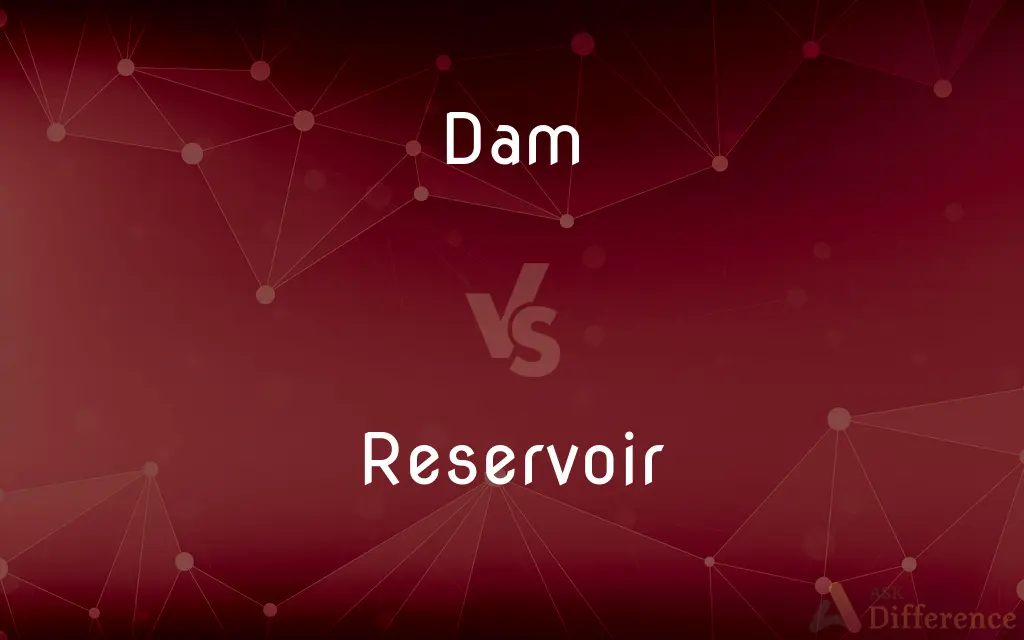Dam vs. Reservoir — What's the Difference?
By Urooj Arif & Maham Liaqat — Updated on March 16, 2024
A dam is a barrier constructed to hold back water and raise its level, forming a reservoir, which is the body of stored water behind the dam, used for water supply, irrigation, and hydroelectric power.

Difference Between Dam and Reservoir
Table of Contents
ADVERTISEMENT
Key Differences
Dams are engineered structures built across rivers or streams to control water flow, prevent floods, and create energy through hydroelectric power generation. They are made of concrete or earth and play a crucial role in water management by storing water, especially in areas prone to drought. Reservoirs, on the other hand, are the artificial lakes that form behind dams as a result of the impounded water. These bodies of water are utilized for various purposes, including irrigation, water supply for domestic and industrial uses, recreational activities, and environmental protection.
The construction of a dam directly leads to the creation of a reservoir. This relationship highlights the functional dependency between the two, where the physical barrier (the dam) enables the storage capacity (the reservoir). While dams are significant for their structural and functional aspects in water management, reservoirs are crucial for their capacity to store large volumes of water, thereby serving as water sources for multiple uses.
Dams have a variety of types, including gravity dams, arch dams, and earthfill dams, each designed according to the geographical and environmental conditions of the site. The choice of dam type affects the creation and management of the reservoir, influencing factors like water storage capacity, evaporation rates, and safety considerations. Reservoirs may vary in size and shape, depending on the natural topography, the purpose of the water storage, and the characteristics of the dam that forms them.
Environmental and ecological impacts are significant considerations in the construction of dams and the formation of reservoirs. Dams can affect river ecosystems, fish migration patterns, and sediment transport. In contrast, reservoirs can create new aquatic and terrestrial habitats but also result in submerged landscapes and potential relocation of communities. Balancing the benefits of dams and reservoirs with their environmental impacts is a key challenge in water resource management.
Both dams and reservoirs play vital roles in flood control. Dams are designed to control the flow of water to prevent downstream flooding, while reservoirs can absorb sudden inflows of water, thereby mitigating the impact of heavy rains and melting snow. This dual functionality is critical in regions where seasonal floods pose significant risks to communities and agriculture.
ADVERTISEMENT
Comparison Chart
Definition
A barrier that holds back water, creating a body of water
The body of water stored behind a dam
Purpose
Flood control, irrigation, hydroelectric power, water supply
Water storage for supply, irrigation, recreation, environmental protection
Construction Material
Concrete, earth, steel
Formed by water impounded by a dam
Environmental Impact
Affects river ecosystems, fish migration, sediment transport
Potential for creating new habitats, but also submerges landscapes
Role in Flood Control
Controls water flow to prevent downstream flooding
Absorbs sudden inflows of water, mitigating flood impact
Compare with Definitions
Dam
Made of materials like concrete or earth.
The earthfill dam is designed to blend with the natural landscape.
Reservoir
Mitigates the impact of floods.
The reservoir absorbed the heavy rain, preventing downstream flooding.
Dam
Affects river ecosystems and sediment transport.
The construction of the dam disrupted local fish migration patterns.
Reservoir
A stored body of water behind a dam.
The reservoir is popular for boating and fishing.
Dam
Designed to prevent floods.
The dam's gates were opened to manage the floodwaters.
Reservoir
Serves multiple uses, including irrigation and water supply.
The reservoir's water irrigates thousands of acres of farmland.
Dam
Plays a crucial role in water management.
The dam's reservoir supplies water to the nearby city.
Reservoir
Can create new aquatic habitats.
The reservoir has become a habitat for various fish species.
Dam
A structure built to control water flow and storage.
The dam across the river provides hydroelectric power.
Reservoir
Submerges landscapes when formed.
The creation of the reservoir submerged an ancient forest.
Dam
A dam is a barrier that stops or restricts the flow of surface water or underground streams. Reservoirs created by dams not only suppress floods but also provide water for activities such as irrigation, human consumption, industrial use, aquaculture, and navigability.
Reservoir
A reservoir (; from French réservoir [ʁezɛʁvwaʁ]) is most commonly an enlarged natural or artificial lake created using a dam to store water. Reservoirs can be created in a number of ways, including controlling a watercourse that drains an existing body of water, interrupting a watercourse to form an embayment within it, through excavation, or building any number of retaining walls or levees.
Dam
A barrier constructed to hold back water and raise its level, forming a reservoir used to generate electricity or as a water supply
The dam burst after torrential rain
The Hoover Dam
Reservoir
A natural or artificial pond or lake used for the storage and regulation of water.
Dam
A rubber sheet used to keep saliva from the teeth during dental operations, or as a prophylactic device during cunnilingus and anilingus.
Reservoir
A receptacle or chamber for storing a fluid.
Dam
The female parent of an animal, especially a domestic mammal.
Reservoir
An underground accumulation of petroleum or natural gas.
Dam
Build a dam across (a river or lake)
The river was dammed to form Lake Powell
Reservoir
(Anatomy) See cisterna.
Dam
A barrier constructed across a waterway to control the flow or raise the level of water.
Reservoir
A large or extra supply; a reserve
A reservoir of goodwill.
Dam
A body of water controlled by such a barrier.
Reservoir
(Medicine) An organism or population that directly or indirectly transmits a pathogen while being virtually immune to its effects.
Dam
A barrier against the passage of liquid or loose material, as a rubber sheet used in dentistry to isolate one or more teeth from the rest of the mouth.
Reservoir
A place where anything is kept in store.
Dam
A female parent of an animal, especially a domesticated mammal such as a horse.
Reservoir
A large natural or artificial lake used as a source of water supply.
Dam
(Archaic) A mother.
Reservoir
A small intercellular space, often containing resin, essential oil, or some other secreted matter.
Dam
To hold back or confine by means of a dam.
Reservoir
A supply or source of something.
Dam
To close up; obstruct
He tried to dam his grief.
Reservoir
A species that acts as host to a zoonosis when it is not causing acute illness in other susceptible species.
Dam
A structure placed across a flowing body of water to stop the flow or part of the flow, generally for purposes such as retaining or diverting some of the water or retarding the release of accumulated water to avoid abrupt flooding.
A dam is often an essential source of water to farmers of hilly country.
Reservoir
(computing) A "black box" component that receives an input signal to be read out and mapped by another process, as part of reservoir computing.
Dam
The water reservoir resulting from placing such a structure.
Boats may only be used at places set aside for boating on the dam.
Reservoir
(transitive) To store or keep (something) in or as in a reservoir.
Dam
(dentistry) A device to prevent a tooth from getting wet during dental work, consisting of a rubber sheet held with a band.
Reservoir
A place where anything is kept in store; especially, a place where water is collected and kept for use when wanted, as to supply a fountain, a canal, or a city by means of aqueducts, or to drive a mill wheel, or the like.
Dam
A reservoir.
Reservoir
A small intercellular space, often containing resin, essential oil, or some other secreted matter.
Dam
A firebrick wall, or a stone, which forms the front of the hearth of a blast furnace.
Reservoir
A large quantity of infectious microorganisms resident in animals other than man, potentially capable of being transmitted to humans.
Dam
Female parent, mother, generally regarding breeding of animals.
Reservoir
A large quantity of infectious microorganisms or parasites resident in animals other than man, potentially capable of being transmitted to humans; especially, such organisms in animals where they do little or no harm to the host.
Dam
A kind of crowned piece in the game of draughts.
Reservoir
A large supply or stock of anything which may be rapidly put to use; a reserve.
Dam
(India) An obsolete Indian copper coin, equal to a fortieth of a rupee.
Reservoir
A large or extra supply of something;
A reservoir of talent
Dam
A former coin of Nepal, 128 of which were worth one mohar.
Reservoir
Lake used to store water for community use
Dam
(transitive) To block the flow of water.
Reservoir
Tank used for collecting and storing a liquid (as water or oil)
Dam
Damn.
Reservoir
Anything (a person or animal or plant or substance) in which an infectious agent normally lives and multiplies;
An infectious agent depends on a reservoir for its survival
Dam
Damn.
Dam
A female parent; - used of beasts, especially of quadrupeds; sometimes applied in contempt to a human mother.
Our sire and dam, now confined to horses, are a relic of this age (13th century) . . . .Dame is used of a hen; we now make a great difference between dame and dam.
The dam runs lowing up and down,Looking the way her harmless young one went.
Dam
A king or crowned piece in the game of draughts.
Dam
A barrier to prevent the flow of a liquid; esp., a bank of earth, or wall of any kind, as of masonry or wood, built across a water course, to confine and keep back flowing water.
Dam
A firebrick wall, or a stone, which forms the front of the hearth of a blast furnace.
Dam
To obstruct or restrain the flow of, by a dam; to confine by constructing a dam, as a stream of water; - generally used with in or up.
I'll have the current in this place dammed up.
A weight of earth that dams in the water.
Dam
To shut up; to stop up; to close; to restrain.
The strait pass was dammedWith dead men hurt behind, and cowards.
Dam
A barrier constructed to contain the flow of water or to keep out the sea
Dam
A metric unit of length equal to ten meters
Dam
Female parent of an animal especially domestic livestock
Dam
Obstruct with, or as if with, a dam;
Dam the gorges of the Yangtse River
Common Curiosities
What is the primary purpose of a dam?
The primary purpose of a dam is to control water flow, prevent floods, and create energy through hydroelectric power.
What materials are used to construct dams?
Dams are constructed from materials like concrete, earth, and steel.
How do reservoirs affect water supply?
Reservoirs store water that can be used for domestic, industrial, and agricultural water supply.
Can reservoirs impact local ecosystems?
Yes, reservoirs can create new habitats but also have the potential to disrupt local ecosystems and submerge landscapes.
How do dams and reservoirs control floods?
Dams control water flow to prevent downstream flooding, while reservoirs can absorb sudden inflows of water.
What are some recreational uses of reservoirs?
Reservoirs are used for recreational activities such as boating, fishing, and swimming.
Do all dams produce hydroelectric power?
Not all dams produce hydroelectric power; it depends on their design and the availability of turbines to generate electricity.
How does a reservoir benefit agriculture?
Reservoirs provide a consistent water supply for irrigation, supporting agriculture even in dry periods.
What role do dams play in irrigation?
Dams play a critical role in irrigation by providing a steady water supply for agricultural fields.
What environmental concerns are associated with dams?
Dams can affect river ecosystems, disrupt fish migration, and alter sediment transport.
Can the construction of a dam lead to community relocation?
Yes, the construction of a dam and the formation of a reservoir can lead to the relocation of communities due to submerged landscapes.
Are reservoirs naturally occurring?
Reservoirs are typically man-made, formed by impounding water behind a dam.
How do dams affect fish migration?
Dams can block traditional migration routes for fish, affecting their breeding and feeding patterns.
How is the size of a reservoir determined?
The size of a reservoir is determined by the dam's design and the natural topography of the surrounding area.
What is the difference between a dam and a levee?
A dam is a barrier that holds back water, forming a reservoir, while a levee is an embankment built to prevent river floods.
Share Your Discovery

Previous Comparison
Pharmacokinetics vs. Pharmacodynamics
Next Comparison
Gustnado vs. TornadoAuthor Spotlight
Written by
Urooj ArifUrooj is a skilled content writer at Ask Difference, known for her exceptional ability to simplify complex topics into engaging and informative content. With a passion for research and a flair for clear, concise writing, she consistently delivers articles that resonate with our diverse audience.
Co-written by
Maham Liaqat














































